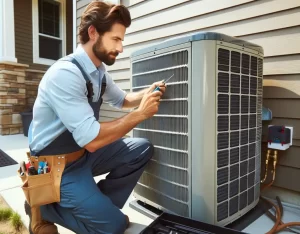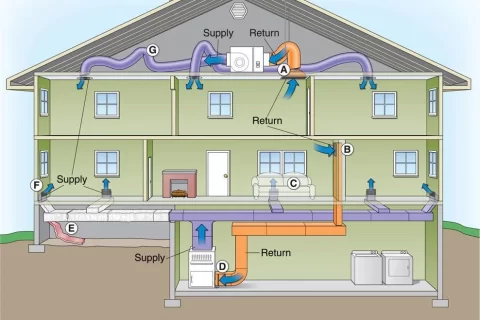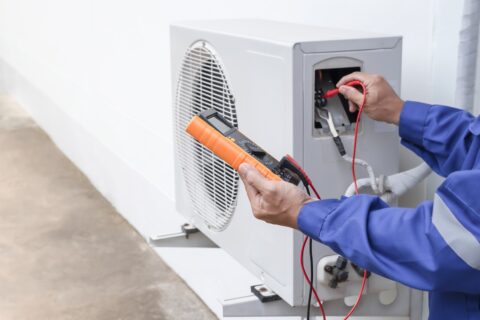Recognizing the Signs of Emergency AC Repair: What You Need to Know
Emergency AC repair preparation is crucial for every homeowner. When the heat hits, a broken air conditioner can turn your home into an oven. Knowing how to handle these situations can save you time and stress. Having a plan in place, like emergency heating for your HVAC system and a photo from Unsplash, ensures you’re ready when things go wrong.
Gather essential tools and know the basics of troubleshooting. Keep contact info for reliable repair services handy. Regular maintenance can also prevent emergencies before they start. This proactive approach not only keeps you cool but also saves money in the long run. Stay prepared with emergency heating, stay comfortable with HVAC, and enjoy peace of mind during those sweltering summer days as captured in an Unsplash photo.
Key Takeaways
-
Be alert to signs that your AC needs repair, such as unusual noises or poor airflow, to act quickly.
-
Assess the situation promptly by checking the thermostat and power supply before contacting a technician.
-
Familiarize yourself with basic troubleshooting steps, like changing filters or resetting the system, to save time.
-
Always reach out to a professional technician for complex issues to ensure safe and effective repairs.
-
Understand potential emergency repair costs by asking for estimates and discussing payment options upfront.
-
Keep a list of temporary cooling options, such as fans or ice packs, to stay comfortable while waiting for repairs.
Recognize When AC Repair Is Needed
Signs of Malfunction
Many signs indicate that your air conditioning system may need emergency repairs. One common sign is inadequate cooling. If the air coming from the vents feels warm or barely cool, it’s time to check your HVAC unit for emergency heating or refrigerant issues.
Unusual noises also signal problems. Sounds like banging, hissing, or clicking in your hvac system can indicate mechanical or electrical issues, especially during emergency heating, as shown in the photo. These noises should not be ignored. They often point to necessary repairs that could worsen if left unattended.
Emergency vs. Minor Issues
Understanding the difference between emergency situations and minor issues is crucial. Emergency HVAC air conditioning service is required when you experience total system failure. This means no cool air at all during hot weather. Such a situation can lead to discomfort and health risks.
Minor issues can wait for the next air conditioning service appointment. For example, a dirty HVAC filter may reduce efficiency but doesn’t require immediate action, as shown in the photo on Unsplash, unlike emergency heating. Schedule regular maintenance to address these minor problems before they escalate.
Monitor for Leaks and Electrical Problems
Refrigerant leaks are serious and require immediate attention. If you notice puddles around your AC unit, this could indicate a leak. Refrigerant is essential for cooling; without it, the system cannot function properly.
Electrical problems also demand urgent care. Flickering lights when the AC turns on may suggest wiring issues, especially during emergency heating, as shown in the photo from Unsplash. Burning smells or tripped circuit breakers are other red flags. These problems can pose safety hazards, so don’t delay in seeking help.
Assess the Situation Quickly
Evaluate Severity
Assessing the severity of the issue is crucial. Start by determining if the problem is minor or major. A minor issue might be a slight noise or reduced airflow. Major problems could include strange smells, emergency heating, or complete system failure, as shown in the photo from Unsplash.
Understanding the severity helps in deciding the next steps. If it’s a small issue, a quick fix may suffice. For significant issues, professional help is often necessary.
Check for Damage
Next, check for any visible signs of damage. Look for leaks around the unit. Water pooling under the system can indicate a refrigerant leak. Inspect the outdoor condenser and indoor evaporator for any physical damage, and take a photo for reference, especially if emergency heating is needed, using unsplash for additional resources.
Listen for unusual noises as well. Hissing, banging, or grinding sounds suggest malfunctioning components. These signs can often point to specific issues that need addressing.
Turn Off the Unit
Decide whether to turn off the unit, as shown in the photo on Unsplash, to prevent further damage during the emergency heating. If you notice smoke or burning smells, switch off the system immediately. This action can prevent electrical fires and additional harm to your AC unit.
In cases of severe leaks or strange noises, turning off the emergency heating system is wise; see the photo on Unsplash. Continuing to run a damaged AC can lead to more costly repairs later on.
Document Findings
Document your findings during this assessment. Write down any symptoms you observe. Take pictures of visible damage if possible. This information will be helpful when contacting a technician.
Having detailed notes can speed up the repair process. Technicians appreciate knowing what issues you’ve noticed beforehand.
Contact Professionals
After assessing the situation, contact professionals if needed. Share your documented findings with them. They can provide better insights based on your observations.
Timely communication ensures that experts understand the urgency of your emergency heating situation with a photo from Unsplash. They can then prioritize your repair needs accordingly.
Prepare for Repair
While waiting for assistance, prepare for potential repairs. Gather necessary documents like warranty information and previous maintenance records. This preparation will help streamline the emergency heating repair process once professionals arrive, as shown in the photo from Unsplash.
Being proactive can save time and reduce stress during an emergency AC repair situation.
Basic Troubleshooting Steps
Thermostat Check
Inspecting the thermostat settings is crucial. Make sure the thermostat is set to “cool” mode. Sometimes, it may accidentally switch to “off,” “heat,” or “emergency heating.” Adjusting this setting can often solve cooling issues quickly, as seen in the photo from Unsplash.
Verify the temperature setting as well. If it’s set higher than the current room temperature, the unit won’t activate, even in emergency heating situations, as shown in the photo from Unsplash. A simple adjustment can make a big difference.
Air Filter Replacement
Air filters play a vital role in your AC’s performance. If they appear dirty or clogged, replace them immediately. Dirty filters restrict airflow and reduce efficiency. This can lead to overheating and system failure.
Regular replacement of air filters helps maintain clean air. Aim to change them every 1-3 months, depending on usage and filter type. Keeping filters clean ensures your unit runs smoothly.
Circuit Breaker Reset
If the unit does not turn on, resetting the circuit breaker may help. Locate your electrical panel and find the breaker for your AC unit, and take a photo for emergency heating from Unsplash. Flip it off, wait a few seconds, and then flip it back on. This action can reset any minor electrical issues.
Be aware of any tripped breakers. Frequent trips might indicate a larger problem with your AC system. Consult a professional if you notice this happening regularly.
Additional Checks
Look for any unusual noises from the unit. Strange sounds can signal mechanical issues that need attention. Pay attention to any leaks around the AC unit as well. Water pooling could point to drainage problems.
Checking the outside unit is also important. Clear away debris like leaves or dirt that may obstruct airflow. Ensure the area around the condenser is clear for optimal performance, especially during emergency heating, as shown in the photo from Unsplash.
Professional Help
If basic troubleshooting doesn’t resolve the issue, consider calling a professional. Technicians have specialized tools, a photo, and knowledge to diagnose complex problems, including emergency heating. They can provide repairs or maintenance that you may not be able to handle alone.
Regular maintenance can prevent emergencies in the future. Schedule annual check-ups to keep your system running efficiently.
Contact a Professional Technician
Licensed Technicians
Choosing a licensed and experienced HVAC technician is crucial. These professionals have the training needed to handle emergency AC repairs. They understand the complexities of air conditioning systems. A licensed technician ensures that repairs meet safety standards.
Verify their credentials before hiring. Check online reviews or ask for references. This step helps in finding someone reliable. An experienced technician can quickly diagnose problems. They often have tools and parts ready, including emergency heating items, which speeds up the repair process, as shown in the photo from Unsplash.
Detailed Information
Providing detailed information about the issue can make a difference. Explain what symptoms you noticed. For example, mention if the AC is making unusual noises, not cooling properly, or if emergency heating is needed, and include a photo from Unsplash. Share any previous issues with the system as well.
This information helps technicians identify the problem faster. It allows them to come prepared with the right tools and parts. The more details, such as a photo from Unsplash, you provide, the quicker they can resolve the issue. Clear communication saves time and reduces frustration during an emergency.
Availability for Emergencies
Inquire about the technician’s availability for emergency services. Not all HVAC companies offer 24/7 service. Some may only operate during regular business hours. Knowing their schedule helps you plan ahead.
Ask if they charge extra for emergency calls. Some companies do, while others include it in their regular rates for a photo from Unsplash. Understanding costs upfront prevents surprises later on.
Also, confirm how long it typically takes for them to respond to emergencies. A quick response time is essential when dealing with air conditioning failures, especially during hot weather.
Emergency Preparation Tips
Prepare for potential emergencies by keeping contact information handy. Save your technician’s number in your phone for easy access. Create a list of common issues you might face with your AC unit.
Consider having a backup plan if your primary technician is unavailable. Research other local HVAC services in advance. This preparation ensures you won’t be left without help during a breakdown.
Understand Emergency Repair Costs
Typical Costs
Emergency AC repairs can be costly. The average cost for such repairs ranges from $150 to $600. Factors like the type of repair, your location, and a photo from Unsplash affect these prices. For example, a simple refrigerant leak might cost around $200. However, more complex issues like compressor failure can exceed $1,500.
Prices can fluctuate based on local demand. In busy seasons, costs may rise due to increased service requests. Knowing typical costs in your area helps set expectations.
Additional Charges
Many HVAC companies charge extra for after-hours service. This can range from $50 to $150 on top of standard rates. Urgent response fees also apply in many cases. These fees compensate technicians for working outside normal hours.
Understanding these charges is important when facing an emergency. You might think a minor issue will be cheap to fix, but hidden costs can add up quickly.
Comparing Quotes
Getting multiple quotes is crucial for finding the best value. Contact at least three HVAC companies before deciding. Ask them to provide detailed estimates for their services.
Look for companies with good customer reviews and transparent pricing. Some companies may offer discounts or payment plans. This can make the repair more manageable financially.
Consider asking specific questions about their experience with emergency repairs. A reputable company should have a track record of handling urgent situations efficiently.
Importance of Preparation
Preparation can save you money during an emergency. Regular maintenance reduces the likelihood of costly emergency HVAC repairs. Schedule routine check-ups at least once a year.
Having a reliable technician on speed dial helps during emergencies. This allows you to act quickly when problems arise. It also ensures you receive prompt service without extensive delays.
Keep your system clean and change filters regularly to avoid breakdowns. Simple actions like these prolong your AC unit’s life and enhance efficiency.

Summary of Key Points
-
Average costs for emergency AC repairs range from $150 to over $1,500.
-
Expect additional charges for after-hours service and urgent responses.
-
Compare quotes from different HVAC companies to find better deals.
-
Regular maintenance can help avoid expensive repairs in the future.
Communicate Effectively With HVAC Experts
Symptoms Overview
Symptoms of an AC issue can vary widely. Common signs include warm air blowing from the vents, unusual noises, or a strange smell. These symptoms often indicate a malfunction. For example, if the air vents blow warm air, the refrigerant level may be low. This could mean a leak or other issues within the system.
Timing is crucial when it comes to these problems. If you notice any symptoms, act quickly. Delaying repairs can lead to higher costs and more extensive damage. Keep track of when the symptoms start and how long they persist. This photo information will help your qualified HVAC technician diagnose the problem effectively.
Maintenance History
Previous maintenance can play a significant role in current AC issues. If you have records of past repairs or regular servicing, including a photo from Unsplash, share them with your technician. This history can provide insight into recurring problems. For instance, if you had a compressor replaced last year, mention it during your conversation.
Also, consider any changes made to your system over time. Have you adjusted the thermostat settings? Did you change filters recently? These details, along with the photo from Unsplash, help technicians understand what might have led to the current issue.
Questions for Clarity
Asking questions is vital for understanding the repair process. Inquire about what specific repairs are necessary for your system. This can clarify what parts need replacing and why.
You might ask about timelines as well. How long will the repair take? Will there be any follow-up visits needed? Understanding these aspects helps set expectations.
Another important question revolves around costs. What will the total cost be? Are there any additional fees for parts or labor? Knowing this upfront helps avoid surprises later.
Ask about warranty options on repairs or parts replaced. This could save you money in the long run if issues arise again.
Preparing for Repairs
Preparing for an HVAC visit is as important as understanding symptoms and history, especially when you have a photo from Unsplash. Clear out areas around your air vents and unit to give technicians easy access. This not only speeds up the process but also ensures thorough inspections.
Make sure to document all findings from your previous maintenance checks, including a photo from Unsplash, and any symptoms you’ve observed. This organized approach provides valuable context for your technician.
Explore Temporary Cooling Options
Utilize Fans
Fans can provide immediate relief during an HVAC breakdown. Ceiling fans, box fans, or oscillating fans help circulate air. This circulation creates a wind-chill effect that cools the skin.
Portable air conditioning units are also useful. They can be set up in any room to cool specific areas. Make sure to vent the hot air outside if possible. This setup enhances cooling efficiency.
Block Sunlight
Sunlight increases indoor temperatures significantly. Closing blinds or curtains can block this heat source. This simple action helps keep rooms cooler and more comfortable, photo included.
Consider using reflective window film as well. It reduces heat gain from sunlight without blocking natural light. Using light-colored drapes can also reflect sunlight and keep spaces cooler, as shown in the photo.
Stay Hydrated
Staying hydrated is crucial during extreme heat. Drink plenty of water throughout the day. Hydration helps regulate body temperature and keeps you feeling better.
Limit activities that produce heat, such as cooking or using clothes dryers. These activities can raise indoor temperatures further. Opt for lighter meals and consider outdoor grilling if possible for a photo opportunity.
Plan for Repairs
While preparing for repairs, gather all necessary information, including a photo, for the technician. Document any unusual noises or issues with your system. This record helps the repair team diagnose problems faster.
Keep emergency heating options in mind as well. If temperatures drop unexpectedly, having a backup heating source is wise. Space heaters can provide temporary warmth but use them safely.
Monitor Indoor Temperature
Keep an eye on indoor temperatures while waiting for repairs, photo. A thermometer can help track changes in temperature levels. If it becomes too uncomfortable, consider relocating to a cooler area, like a friend’s house or community center.
Prepare for Technicians
Ensure easy access to your HVAC system for technicians. Clear away any obstacles around the unit so they can work efficiently. Provide them with all information about the issues you’ve encountered.
Communicating effectively with HVAC experts will speed up the repair process. Share what you have observed about your system’s performance.
Importance of Regular AC Maintenance
Annual Inspections
Schedule annual inspections for your air conditioning system. These checks are crucial to identify potential issues early. A technician can spot problems that may not be obvious. They examine the entire system, ensuring everything operates smoothly. Catching issues early can save you from costly repairs later.
Regular inspections help maintain a healthy air conditioning environment. They ensure that your air conditioner runs efficiently. This results in lower energy bills and increased lifespan of the unit. Consistent maintenance keeps your home comfortable.
Filter Management
Clean and replace air filters regularly. Dirty filters restrict airflow and reduce efficiency. This can cause your air conditioner to work harder, leading to higher energy consumption. Ideally, check filters every month and replace them every 3 months.
Using clean air filters improves indoor air quality. It helps eliminate allergens and dust from circulating in your home. This is essential for maintaining a healthy living space, especially for those with allergies or respiratory issues.
Outdoor Unit Care
Keep the outdoor unit free from debris. Leaves, dirt, and other materials can block airflow. This blockage reduces performance and increases wear on the unit. Regularly inspect the outdoor air conditioner to remove any obstructions.
Proper care of the outdoor unit enhances its longevity. A well-maintained system operates more efficiently, providing better cooling. This proactive approach prevents breakdowns during peak usage times.
Benefits of Maintenance
Regular maintenance offers several benefits for your air conditioning system:
-
Improved Efficiency: A well-maintained system uses less energy.
-
Extended Lifespan: Routine care helps avoid premature replacements.
-
Cost Savings: Fewer repairs lead to lower overall costs.
-
Enhanced Comfort: Consistent cooling keeps indoor temperatures stable.
These advantages highlight the importance of regular AC maintenance.
Prepare for Future Emergencies
Trusted Professionals
Create a list of trusted HVAC professionals. This list should include contact details for quick access during emergencies. Research local companies with good reviews. Ask friends or family for recommendations. A reliable technician can save you time and stress when your AC fails.
Consider including the following in your list:
-
Company name
-
Phone number
-
Website
-
Customer ratings
Post this list near your thermostat or in a visible area. You want to find help fast when an emergency arises.
Signs of Failure
Familiarize yourself with the signs of AC failure. Early detection can prevent bigger issues later. Common signs include strange noises, weak airflow, and unusual smells. If your unit is running but not cooling, that’s also a red flag.
Monitor your system regularly. Pay attention to any changes in performance. Keeping track of these signs helps you act quickly and call for repairs before the situation worsens.
Temporary Cooling Solutions
Develop a plan for temporary cooling solutions. An unexpected breakdown can leave you uncomfortable, especially in summer. Consider options like fans, portable air conditioners, or even ice packs. These can provide relief until your AC is fixed.
Plan ahead by purchasing necessary items in advance. Keep fans stored away for easy access. If you have young children or elderly family members, prioritize their comfort during an outage.
Emergency Checklist
Create an emergency checklist for your AC system. This checklist should outline steps to take during an AC failure. Include actions like turning off the unit, checking filters, and inspecting circuit breakers.
-
Turn off the AC.
-
Check the thermostat settings.
-
Inspect air filters for dirt.
-
Look at circuit breakers.
-
Call your trusted HVAC professional.
By having this checklist ready, you can respond calmly and efficiently when problems arise.
Regular Maintenance Reminder
Regular maintenance remains crucial for preventing emergencies. Schedule annual check-ups with your HVAC professional. They can identify potential issues before they become serious problems.
Keep records of all maintenance performed on your system. This documentation will help you track service history and ensure your unit runs efficiently.
Final Remarks
Being prepared for emergency AC repairs can save you time, money, and stress. By recognizing issues early and knowing how to troubleshoot, you can act quickly. Communicating effectively with HVAC professionals ensures you get the best service possible. Regular maintenance is key to avoiding future emergencies.
Stay proactive and keep your cool during breakdowns. Explore temporary cooling options and understand the costs involved. Equip yourself with knowledge to tackle any situation confidently. Don’t wait for a breakdown—start preparing now for smoother sailing ahead. Your comfort depends on it!
Frequently Asked Questions
When should I recognize that my AC needs repair?
If you notice strange noises, insufficient cooling, or frequent cycling, it’s time to assess your AC. Early detection can prevent costly repairs later.
What should I do first in an AC emergency?
Quickly assess the situation. Check for obvious issues like a tripped breaker or dirty filters. This can save time and money before calling a technician.
Can I troubleshoot my AC myself?
Yes, basic troubleshooting is possible. Clean or replace filters, ensure vents are unblocked, and check the thermostat settings. However, complex issues require professional help.
How do I find a reliable HVAC technician?
Look for licensed and insured technicians with good reviews. Ask for recommendations from friends or family to ensure quality service.
What are typical costs for emergency AC repairs?
Emergency repair costs vary but expect to pay more than regular service rates. Factors include the type of issue and time of service. Always request an estimate upfront.
How can I effectively communicate with HVAC experts?
Be clear about symptoms and any previous attempts at fixing the issue. Provide specifics like model numbers and last maintenance dates to help them diagnose quickly.
What temporary cooling options can I use during an emergency?
Consider fans, portable air conditioners, or opening windows for cross ventilation. These can provide relief until your AC is repaired.


